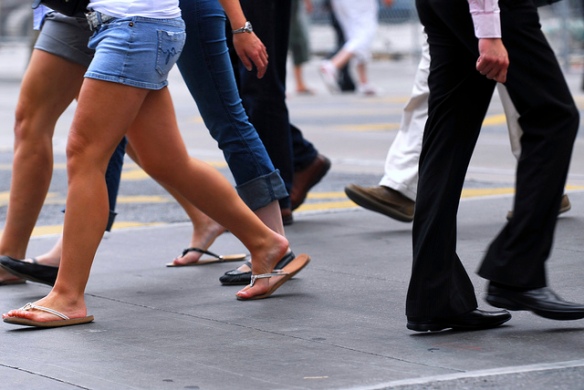Photo by SyncHealth
This post is the first in a three-part series about changing perceptions around health and wellness in the U.S. The series will explore a variety of issues: How changing ideas about wellness are impacting the lifestyle choices of individuals (part 1), our environments and interactions (part 2), and the development and design of products (part 3). We hope you’ll return in early February for the rest of the series and share your thoughts and ideas along the way!
* * * * *
When Jill Horning graduated from the University of Michigan and moved to West Michigan to work for izzy+, she adopted an approach to wellness that was culturally common—especially a decade or two ago.
“I drove to work, stayed at my desk all day, then drove home,” says Jill, now izzy+’s E-marketing specialist.
Jill has always been health-conscious, so she did have a membership at the YMCA and says she tried to fit in a workout whenever she could. But exercise definitely wasn’t a natural, daily activity.
It was in 2012, when Jill moved to Chicago to work at the izzy+ showroom, that her approach to wellness shifted.
“Once I moved to the city I started walking everywhere,” Jill says. “I should have just sold my car then and there!”
Jill now walks 25 minutes to and from work each day, in addition to her periodic runs and more structured workouts.
“When I started walking to work I honestly didn’t know if it would last, but after two weeks I noticed how great I felt and I didn’t want to think about taking the bus,” she says. “Now when I go work in the Michigan office for a week, I notice how lethargic I am. I really need that fresh air and exercise at the beginning and end of each day.”
This approach to wellness—weaving physical activity into the fabric of each day rather than taking it in sporadic bursts—is definitely a trend experts are observing. Today, physical fitness is thought of less as focus just for athletes and fitness fanatics, and more as something that’s for everyone.
Michelle Maloney (MS, MBA, CPT), an acquisitions editor at Human Kinetics, a publisher specializing in the physical activity field, says this trend comes partly out of a broadened awareness of health issues and the many lifestyle choices that have led to them.
“I think there is more awareness than ever of the need for people to improve their health and change their lifestyle,” Michelle says, pointing to news stories about obesity and related health risks, and also the rising costs of healthcare. She says 60 percent of the adult U.S. population is considered sedentary.
“It’s kind of snowballed, until it’s reached a point where obesity rates are so high, we have to pay attention.”
The shift away from complicated diets and exercise regimes toward what Michelle calls “behavior change” is key to success for most people, as research done at the Cooper Institute indicates.
“It’s a matter of getting back to basics with nutrition and activity,” Michelle says. “It’s hard to do, because these things have been engineered out of what we do every day.”
During the past 50 years, everything from the invention of office technology and the design of cubicles to the development of automobile-reliant suburbs has played a part in engineering physical activity out of our lives. But the tide is shifting as cities work to become more walkable and bikeable, and as workplaces move toward open, collaborative spaces that encourage movement throughout the day.
“Everywhere you look there’s more of a focus on well-rounded wellness and happiness, with more realistic expectations,” Michelle says.
Not only has Jill, a twenty-something, seen that trend play out in her life, but her mom, Amey Horning, recognizes a shift in her perspective, too.
“I used to be on and off about exercise,” says Amey. “What I’m learning now is that it’s all about balancing mind, body and spirit. My approach changed when my life changed due to divorce. I decided I needed to get back to me, to quiet my mind and focus on being well.”
Whether she’s getting outdoors for cross-training, meditating on her own at home, or going to yoga class at the Lakeshore Yoga Center in Grand Haven, Michigan, Amey says the combination leads to feeling less stressed and more healthy, in every way.
“My parents are 80 and 82, but they weren’t as active later in their life, so their bodies seem older than they are,” Amey says. “It puts a little fear in me, and inspires me to make the positive changes I can make in my own life. Our choices really matter.”
* * * * *
What changes have you noticed in your own approach to wellness? If you need some inspiration, read more about recent research and tips to KEEP MOVING:
Low Intensity Activity Can Have Health Benefits looks at the health risks associated with men who spend five or more hours a day sitting, and why regular movement throughout the day is important in addition to exercise.
Sitting is the new smoking—even for runners explores similar research that points to how regular daily exercise—even up to 60 minutes a day—does not alone negate the adverse effects of sitting.
A guide to assessing and improving your posture—understand better ways of sitting and standing, and learn yoga poses that will help you strengthen and refine.
5 yoga poses to boost the immune system by increasing the circulation of blood cells, decreasing stress hormones, and stimulating the lymphatic system.



